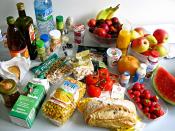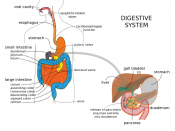Science 10 Assignment -- Part B
How Nutrients get in, and wastes out.
In a human being, nutrients are necessary for survival. But how are these nutrients obtained? This report will go into depth on how the food we eat gets into our cells, and how the waste products that we produce get out of the body. Also, the unicellular organism Paramecium will be compared with a human being, in terms of all of the above factors.
Dietary Nutrients
The chief nutrients in a diet are classified chemically in four groups: carbohydrates, proteins, vitamins (Which do not require digestion) and fats.
Carbohydrates in the diet occour mainly in the form of starches. These are converted by the digestive process to glucose, one of the main nutrients needed for cellular respiration to occour. Starch is a large molecule, a polymer of glucose. Dextrin and maltose are intermediate products in the digestion of starch.
Some foods contain carbohydrates in the form of sugars. These are the simple sugars, such as sucrose (cane sugar) or lactose (milk sugar), that must be processed into smaller units. Occasionally, the simplest form of sugar, a monosaccharide such as glucose, is present in food. These monosaccharides do not require digestion.
Proteins are polymers composed of one or more amino acids. When they are digested, they produce free amino acids and ammonia.
Vitamins are a vital part of our food that are absorbed through the small intestine. There are two different types of vitamins, water-soluble (All the B vitamins, and vitamin C) and fat-soluble (vitamins A, D and K).
Neutral fats, or triglycerides, are the principal form of dietary fat. They are simple compounds, and within digestion are broken down into glycerol and fatty acids, their component parts.
Ingestion
Intake of food in the Paramecium is controlled by...



Cool
thx.. this helpend me alot.
8 out of 8 people found this comment useful.